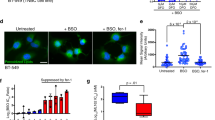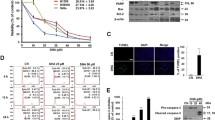Abstract
Both of ceramide and PPARγ ligand can trigger cancer cell apoptosis. We here show that C2-ceramide can modulate PPARγ expression level and its transcriptional activity and results in apoptosis in HT29 cells. Administration of PPARγ specific antagonist GW9662 partially prevents HT29 cells from apoptosis. Furthermore, MAP kinase pathway provided a potential modulation mechanism for PPARγ pathway related with ceramide. Our results are the first to demonstrate that C2-ceramide induces apoptosis via a PPARγ-dependent pathway.
Similar content being viewed by others
References
Herr I, Wilhelm D, Bohler T, Angel P, Debatin KM (1997) Activation of CD95 (APO-1/Fas) signaling by ceramide mediates cancer therapy-induced apoptosis. Embo J 16:6200–6208
Burow ME et al (1998) Differences in susceptibility to tumor necrosis factor alpha-induced apoptosis among MCF-7 breast cancer cell variants. Cancer Res 58:4940–4946
Selzner M et al (2001) Induction of apoptotic cell death and prevention of tumor growth by ceramide analogues in metastatic human colon cancer. Cancer Res 61:1233–1240
Mangelsdorf DJ et al (1995) The nuclear receptor superfamily: the second decade. Cell 83:835–839
Chinetti G et al (1998) Activation of proliferator-activated receptors alpha and gamma induces apoptosis of human monocyte-derived macrophages. J Biol Chem 273:25573–25580
Takahashi N et al (1999) Activation of PPARgamma inhibits cell growth and induces apoptosis in human gastric cancer cells. FEBS Lett 455:135–139
Al-Makdissy N et al (2001) Down-regulation of peroxisome proliferator-activated receptor-gamma gene expression by sphingomyelins. FEBS Lett 493:75–79
Sprott KM, Chumley MJ, Hanson JM, Dobrowsky RT (2002) Decreased activity and enhanced nuclear export of CCAAT-enhancer-binding protein beta during inhibition of adipogenesis by ceramide. Biochem J 365:181–191
Rosenbaum SE, Greenberg AS (1998) The short-and long-term effects of tumor necrosis factor-alpha and BRL 49653 on peroxisome proliferator-activated receptor (PPAR)gamma2 gene expression and other adipocyte genes. Mol Endocrinol 12:1150–1160
Perrey S et al (2001) Thiazolidinedione- and tumor necrosis factor alpha-induced downregulation of peroxisome proliferator-activated receptor gamma mRNA in differentiated 3T3-L1 adipocytes. Metabolism 50:36–40
Leesnitzer LM et al (2002) Functional consequences of cysteine modification in the ligand binding sites of peroxisome proliferator activated receptors by GW9662. Biochemistry 41:6640–6650
Willson TM, Brown PJ, Sternbach DD, Henke BR (2000) The PPARs: from orphan receptors to drug discovery. J Med Chem 43:527–550
Derijard B et al (1994) JNK1: a protein kinase stimulated by UV light and Ha-Ras that binds and phosphorylates the c-Jun activation domain. Cell 76:1025–1037
Han J, Lee JD, Bibbs L, Ulevitch RJA (1994) MAP kinase targeted by endotoxin and hyperosmolarity in mammalian cells. Science 265:808–811
Hu E, Kim JB, Sarraf P, Spiegelman BM (1996) Inhibition of adipogenesis through MAP kinase-mediated phosphorylation of PPARgamma. Science 274:2100–2103
Rosen ED, Walkey CJ, Puigserver P, Spiegelman BM (2000) Transcriptional regulation of adipogenesis. Genes Dev 14, 1293–1307
Bushnell DA, Westover KD, Davis RE, Kornberg RD (2004) Structural basis of transcription: an RNA polymerase II-TFIIB cocrystal at 4.5 Angstroms. Science 303:983–988
Bull AW (2003) The role of peroxisome proliferator-activated receptor gamma in colon cancer and inflammatory bowel disease. Arch Pathol Lab Med 127:1121–1123
Elstner E et al (1998) Ligands for peroxisome proliferator-activated receptorgamma and retinoic acid receptor inhibit growth and induce apoptosis of human breast cancer cells in vitro and in BNX mice. Proc Natl Acad Sci USA 95:8806–8811
Kubota T et al (1998) Ligand for peroxisome proliferator-activated receptor gamma (troglitazone) has potent antitumor effect against human prostate cancer both in vitro and in vivo. Cancer Res 58:3344–3352
Heaney AP, Fernando M, Yong WH, Melmed S (2002) Functional PPAR-gamma receptor is a novel therapeutic target for ACTH-secreting pituitary adenomas. Nat Med 8:1281–1287
Keshamouni VG et al (2004) Peroxisome proliferator-activated receptor-gamma activation inhibits tumor progression in non-small-cell lung cancer. Oncogene 23:100–108
Alarid ET, Bakopoulos N, Solodin N (1999) Proteasome-mediated proteolysis of estrogen receptor: a novel component in autologous down-regulation.Mol Endocrinol 13:1522–1534
Nawaz Z, Lonard DM, Dennis AP, Smith CL, O’Malley BW (1999) Proteasome-dependent degradation of the human estrogen receptor. Proc Natl Acad Sci USA 96, 1858–1862
Zhu J et al (1999) Retinoic acid induces proteasome-dependent degradation of retinoic acid receptor alpha (RARalpha) and oncogenic RARalpha fusion proteins. Proc Natl Acad Sci USA 96:4807–14812
Hauser S et al (2000) Degradation of the peroxisome proliferator-activated receptor gamma is linked to ligand-dependent activation. J Biol Chem 275:18527–18533
Chen GG et al (2002) Apoptosis induced by activation of peroxisome-proliferator activated receptor-gamma is associated with Bcl-2 and NF-kappaB in human colon cancer. Life Sci 70:2631–2646
Yang WL, Frucht H (2001) Activation of the PPAR pathway induces apoptosis and COX-2 inhibition in HT-29 human colon cancer cells. Carcinogenesis 22:1379–1383
Riboni L et al (2002) Ceramide levels are inversely associated with malignant progression of human glial tumors. Glia 39:105–113
Han J, Lee JD, Tobias PS, Ulevitch RJ (1993) Endotoxin induces rapid protein tyrosine phosphorylation in 70Z/3 cells expressing CD14. J Biol Chem 268: 25009–25014
Zhao S, Yang YN, Song JG (2004) Ceramide induces caspase-dependent and -independent apoptosis in A-431 cells. J Cell Physiol 199:47–56
Li, M et al (2005) Activation of peroxisome proliferator-activated receptor-gamma by troglitazone (TGZ) inhibits human lung cell growth. J Cell Biochem 96:760–774
Paccani SR et al (2005) Nonsteroidal anti-inflammatory drugs inhibit a Fyn-dependent pathway coupled to Rac and stress kinase activation in TCR signaling. Blood 105:2042–2048
Chen A, Xu J (2005) Activation of PPAR{gamma} by curcumin inhibits Moser cell growth and mediates suppression of gene expression of cyclin D1 and EGFR. Am J Physiol Gastrointest Liver Physiol 288:G447–456
Oh HL, Seok JY, Kwon CH, Kang SK, Kim YK (2006) Role of MAPK in ceramide-induced cell death in primary cultured astrocytes from mouse embryonic brain. Neurotoxicology 27: 31–38
Stoica BA, Movsesyan VA, Knoblach SM, Faden AI (2005) Ceramide induces neuronal apoptosis through mitogen-activated protein kinases and causes release of multiple mitochondrial proteins. Mol Cell Neurosci 29:355–371
Rahmani M et al (2005) Coadministration of histone deacetylase inhibitors and perifosine synergistically induces apoptosis in human leukemia cells through Akt and ERK1/2 inactivation and the generation of ceramide and reactive oxygen species. Cancer Res 65:2422–2432
Ahn EH, Schroeder JJ (2006) Sphinganine causes early activation of JNK and p38 MAPK and inhibition of AKT activation in HT-29 human colon cancer cells. Anticancer Res 26:121–127
Morgan DO (1997) Cyclin-dependent kinases: engines, clocks, and microprocessors. Annu Rev Cell Dev Biol 13:261–291
Chang L, Karin M (2001) Mammalian MAP kinase signalling cascades. Nature 410:37–40
Chen J, Larochelle S, Li X, Suter B (2003) Xpd/Ercc2 regulates CAK activity and mitotic progression. Nature 424:228–232
Chen D et al (2000) Activation of estrogen receptor alpha by S118 phosphorylation involves a ligand-dependent interaction with TFIIH and participation of CDK7. Mol Cell 6:127–137
Bastien J et al (2000) TFIIH interacts with the retinoic acid receptor gamma and phosphorylates its AF-1-activating domain through cdk7. J Biol Chem 275: 21896–904
Weigel NL (1996) Steroid hormone receptors and their regulation by phosphorylation. Biochem J 319 (Pt 3): 657–667
Author information
Authors and Affiliations
Corresponding author
Additional information
J. Wang and X. Lv contributed equally to this work.
Rights and permissions
About this article
Cite this article
Wang, J., Lv, X., Shi, J. et al. Ceramide induces apoptosis via a peroxisome proliferator-activated receptor γ-dependent pathway. Apoptosis 11, 2043–2052 (2006). https://doi.org/10.1007/s10495-006-0191-9
Published:
Issue Date:
DOI: https://doi.org/10.1007/s10495-006-0191-9




